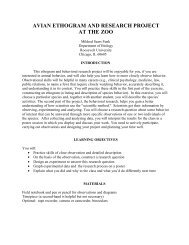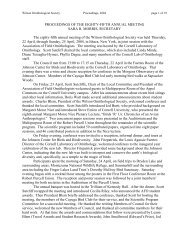Available now - Wilson Ornithological Society
Available now - Wilson Ornithological Society
Available now - Wilson Ornithological Society
You also want an ePaper? Increase the reach of your titles
YUMPU automatically turns print PDFs into web optimized ePapers that Google loves.
WOS 2010 ~ ABSTRACTS p. 16<br />
07 S Development of a bird community integrity index to monitor salt marsh condition at National Wildlife Refuges.<br />
Whitney A. Wiest and W. Gregory Shriver, Dept. Entomology and Wildlife Ecology, Univ. Delaware, Newark, DE<br />
19716, and Hal Laskowski, U.S. Fish and Wildlife Service, Milton, DE 19968<br />
Coastal refuges in the National Wildlife Refuge System protect approximately 1,045,925 acres of salt marsh habitat<br />
in the lower 48 states. Appropriate assessment and monitoring tools are necessary to provide refuge managers with<br />
the ability to determine overall marsh condition in order to maintain or improve the integrity of refuge marshes.<br />
Birds are an appropriate study taxa because they are linked to the overall ecological integrity of their respective<br />
ecosystems and are relatively easy to monitor. During the summers of 2008 and 2009 call-broadcast surveys were<br />
performed at 184 points across nine National Wildlife Refuges and Refuge Complexes on the eastern seaboard. We<br />
tested a bird community integrity (BCI) index to evaluate the marsh bird community integrity at each survey point.<br />
The developed index was based on a previously published index (DeLuca et al. 2004). Species were assigned a<br />
species-specific integrity score based on a combination of species’ attributes (i.e., foraging habit, nesting habit, and<br />
conservation rank). The index evaluated the sum of the detected species’ scores and a component of relative<br />
abundance to calculate point integrity scores. BCI scores were used to compare management treatments of marsh<br />
units within refuges. Significant differences were found between tidally restricted areas and other management<br />
types. We also estimated the percent of habitat cover around each point to evaluate landscape effects on BCI.<br />
08 Winter association of birds with the invasive exotic Brazilian pepper (Schinus terebinthifolius). Jerome A.<br />
Jackson, Dept. Marine and Ecological Sciences, Florida Gulf Coast Univ., Ft. Myers, FL 33965, and Bette J. S.<br />
Jackson, Dept. Biological Sciences, Florida Gulf Coast Univ., Ft. Myers, FL 33965<br />
Brazilian pepper (Schinus terebinthifolius) was introduced to North America in the 1800s and has since become an<br />
abundant invasive exotic in south Florida, forming dense stands of shrubby trees to the exclusion of native<br />
vegetation. We studied bird associations with this plant in southwest Florida and found abundant use of it by<br />
wintering birds as shelter and a source of food. Brazilian pepper blooms through the winter, its tiny white flowers<br />
attracting small insects that pollinate it — and Blue-gray Gnatcatchers, White-eyed Vireos, and wintering wood<br />
warblers, which feed on the insects. During November through February Brazilian pepper produces clusters of red<br />
fruits, which are eaten by Gray Catbirds, Northern Mockingbirds, European Starlings, American Robins, and other<br />
species. Many bird species find shelter within and beneath this tree's dense foliage. Relationships between birds and<br />
Brazilian pepper range from commensal to mutualistic; several species spread the seeds of the plants.<br />
09 S Individuality and recognition in the Great Black-backed Gull, Larus marinus. Christina Masco and Thomas D.<br />
Seeley, Neurobiology and Behavior, Cornell Univ., Ithaca, NY 14850<br />
The Great Black-backed Gull nests in large colonies, occupying territories throughout the breeding season. Territory<br />
boundaries are constantly in contention, and individuals employ specific calls and displays to enforce these<br />
boundaries. One such call is the 'yeow', an aggressive warning call directed at intruders. To test whether gulls are<br />
capable of recognizing each other's calls, I recorded the yeows of 22 individuals and used these recordings as stimuli<br />
in a series of playback experiments. Each playback trial consisted of three conditions in which I varied the source of<br />
the call: mate, neighbor, and stranger. The gulls did not differentiate between mate and neighbor (permutation test, P<br />
= 0.103 and P = 0.187 respectively), but maintained an alert posture in response to a stranger's call significantly<br />
longer than expected (permutation test, P = 0.008). To determine what features of the yeow allow for this<br />
discrimination, I analyzed variation in call structure using spectrographic cross-correlation and principle components<br />
analysis. Caller identity proved to be a strong predictor of variation along the first principle components axis, PCO1<br />
(ANOVA, F-value = 44.50, p < 0.0001). PCO1 showed a strong correlation with yeow duration (R-square = 0.83, p<br />
< 0.0001), suggesting that much of the individual variation among these gulls lies call duration, and this parameter<br />
may be the basis for recognition. Considering the prevalence of intraspecific predation in the Great Black-backed<br />
Gull colonies, the ability to detect unfamiliar calls is highly adaptive.<br />
10 S Influence of adult age on Rose-breasted Grosbeak nestling provisioning rates in stands harvested by single-tree<br />
selection. Sonya Richmond and J. Malcolm, Faculty of Forestry, Univ. Toronto, Toronto, ON M5S 3B3, E. Nol,<br />
Dept. Biology, Trent Univ., Peterborough, ON K9J 7B8, and D. Burke, Ministry of Natural Resources, London, ON<br />
N6E 1L3<br />
We conducted this study to test whether younger, less experienced Rose-breasted Grosbeaks were able to provide<br />
their nestlings with as much food as older, more experienced adults, both in stands harvested by single-tree selection<br />
and in uncut sites. We compared 1) nestling provisioning rates (#trips/nestling/hr), 2) prey load size, and 3) the<br />
proportion of nestling provisioning and nest attendance contributed by after-second-year (ASY) males and secondyear<br />
(SY) males in cut versus uncut sites. We monitored 87 nests in eight harvested and four unharvested hardwood<br />
stands in Algonquin Provincial Park during 2007 and 2008. Nestling provisioning rates, prey load sizes, and the<br />
proportion of nestling provisioning and nest attendance contributed by males did not significantly differ in harvested<br />
and unharvested stands, so nests were pooled for comparison of these parameters between nests with older versus





